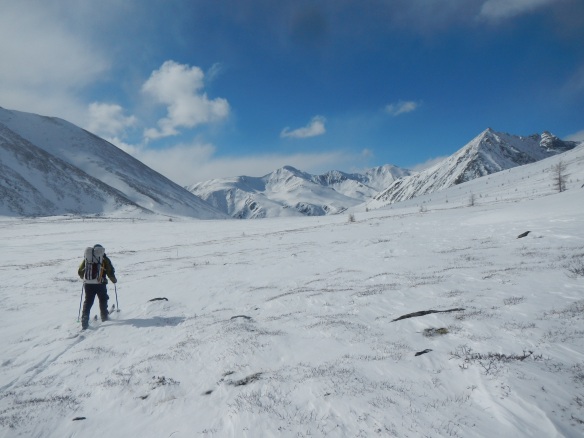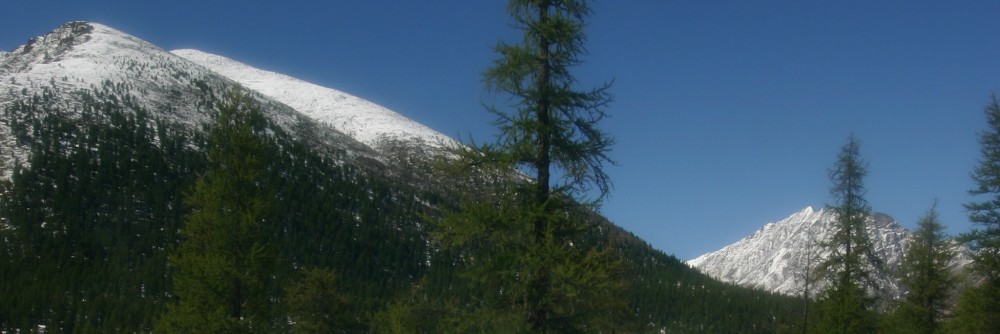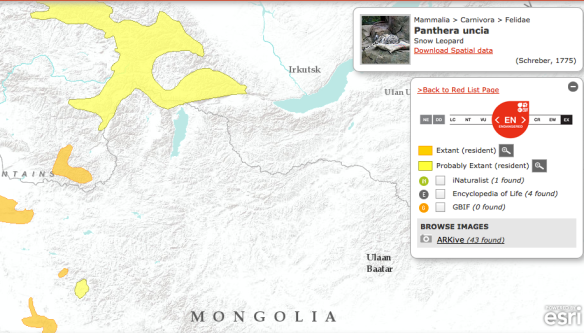I first went to the mountains of Hovsgol, Mongolia, in 2001, as a volunteer on snow leopard track surveys sponsored by the Mongolian government and the International Snow Leopard Trust. With two fellow Peace Corps volunteers and a Hovsgol National Park ranger, I spent nine days in the Horidol Sardag, the range that arcs along the southeastern curve of the Darhad, searching for snow leopard sign and for evidence of the snow leopard’s primary prey species, ibex and argali. At that time, American-style wildlife research in Mongolia was still in its infancy, and although the local community had reported snow leopard presence in the mountains around the Darhad, the international scientific community hadn’t been able to confirm these reports. They were still searching, throughout the country, for population nodes of the big cats and their prey.
The Horidol Sardag left me in awe. It was the first time I had traveled across an expanse of country for nine days without encountering anyone outside my own party. The place felt vast, and empty of human influence, and therefore whole and connected in a way that I’d never experienced before. It wasn’t that the country was unpopulated – it was the awareness of the fact that people had lived here for thousands of years without wrecking the place. The landscape had presence, a kind of quiet awareness that seemed nearly conscious in its intensity. We never found the snow leopards, nor any sign of argali; the only evidence of ibex was a worn old skull lying in the middle of a dry drainage up high. But we heard wolves at night, and saw elk and ptarmigan and deer. And the sense of awareness and watchfulness I attributed in part to the presence of snow leopards, somewhere beyond our sight, because predators lend electricity to a landscape, even when you can’t see them. By the time the survey was over, I’d developed a fascination with the species, because they lived in the mountains and were solitary and wide-ranging and tied to the snow and cold. These were all characteristics that I admired.
At the time, I was unaware that there was another unseen mountain beast running around in the Horidol Sardag. When I started talking with wolverine biologists in 2006 about a potential project in Mongolia, I was struck by the similarities between wolverines and snow leopards. These similarities made it easy to expand a fascination with snow leopards to encompass wolverines as well. One of my initial questions – still a topic of interest – involved possible interactions and competition among snow leopards, wolverines, and wolves. Another, of course, has to do with the vulnerability of snow leopards to climate change, and whether that vulnerability is as acute as that of wolverines. There are other hypotheses as well. Much as I love wolverine work in the US, the prospect of being back in mountains that contained snow leopards and wolverines fueled a large part of my drive to start working in Mongolia.
In 2009, I began interviewing herders and hunters throughout Mongolia, searching for information on wolverines, which had never been formally documented in the country. I took a packet of animal photographs everywhere I went, because I didn’t want interviewees to know exactly which species I was interested in. I would pull out the cards and ask people to sort the pictures into piles, representing animals that lived in the area, and animals that did not. Pooled over several interviews in a single region, trends began to emerge. One particularly interesting trend came from the interview data in the Darhad: people persistently reported snow leopard presence. The scientific community still hadn’t verified presence since the surveys in 2001, but hunters insisted that snow leopards were around. So did Tumursukh, the director of the Darhad’s three protected areas, when I spoke to him last September about the prospect of a wolverine camera project in the region. He was enthusiastic, not only because of wolverines, but because he was sure that the cameras would turn up evidence of snow leopards, too. The IUCN depicts the area as containing a “probably extant” resident population, so the perception that there were as-yet-scientifically-undetected snow leopards in these mountains was widespread.
The data trends regarding wolverines were interesting as well. Interviewees sometimes used the word hovor (“rare”) to describe the species, but many of them referred to wolverines as elbeg (“abundant”), especially during the winter months. All of them told me that if I came back when there was snow on the ground, I would definitely find tracks. They described the tracks as being all over the place, and easily found.
This didn’t entirely make sense. Wolverines are never abundant; they’re naturally rare, even when the landscape is saturated. But part of the impetus for doing wolverine work in Mongolia stemmed from initial, relatively vague reports that Mongolian wolverines might be doing things differently from their kin in the rest of the world. I didn’t want to dismiss anything, no matter how odd, so I added several hypotheses to the running list, and discussed, with the project’s scientific advisor Jason Wilmot and with Mongolian colleagues, the option of doing a series of transects while snow was on the ground, to see if we could get some kind of bearing on whether wolverines in the Darhad were elbeg, hovor, or somewhere in between. We saw this as a prelude to a more in-depth study.
That was the inception. Now I’m going to skip to the end, with promises to fill in the middle soon.
We ended up doing the track survey with a team of five Americans, sponsored by National Geographic. I would have preferred to have at least one Mongolian on the team, but the logistical realities, and the difficulty of finding someone with adequate ski experience, precluded this. We set out in late March, and skied until late April, covering approximately 230 miles, with resupplies managed by the multi-talented Mishig and the rest of the equally talented team at Boojum Expeditions. This was my first long expedition, so there was plenty of learning for me. But they were, in a way, my mountains; I’d traveled around in them in bits and pieces over the course of twelve years, and they felt comfortable.
Living in the cold, camping in the snow, and bundled into layers of warm winter clothing, we became snow beasts of the Darhad too.
And our experiences matched those of my Mongolian interviewees – there were wolverine tracks everywhere. I remain stunned by how many tracks we detected. Even though I have high confidence in the accuracy of the information I obtained from the interviews, I did not anticipate finding tracks every day – but we did. I’m not going to mention any conclusions here, but my mind is spinning, in a good way. It’s been spinning too fast to write anything for the past few weeks, but the pieces are finally starting to fall into place. It’s an exciting feeling.
Our experience also aligned with those of my Mongolian friends in another way. Twelve years after my first trip through the Horidol Sardag, I finally saw snow leopard tracks in the mountains of Hovsgol. Skiing over the high, barren, and beautiful country at a place called Utrag Pass, I suddenly felt that electricity again, the sense of presence. A few minutes later, I paused at a set of strange tracks that moved across the crusted snow in a way that said “cat.” Jason and two other expedition members ended up documenting them as I skied on ahead, the victim of a heavy pack that necessitated continuing so that I could make adequate time. The tracks were fresh, and they were definitely not lynx, the only other big cat in the region.

Forrest McCarthy, the expedition’s official adventure-geographer, skis across the high country of Utrag Pass.
When we got back to Ulaanbaatar, I sent the track photos to friends who work on snow leopard projects elsewhere in the world. Fellow expedition members did the same, and the photos went out to a variety of experts. They all verified the ID. Panthera, the renowned big cat conservation organization, generously arranged the loan of some cameras to deploy this summer, in conjunction with a camera-trap training for Tumursukh and the park rangers.
I am excited about this snow leopard mini-project, but there’s a peculiar tension between the two disciplines in which I work. As an anthropologist, I trust the accuracy of the information that I receive from Mongolian herders and hunters, and I know that no matter what kind of background I bring to my work here, I will never know as much about the environment and wildlife of the region as they do. Full credit goes to the community of people who have kept these wildlife populations on the landscape and who understand them far better than I ever will. I have no aspirations to participate in an outmoded colonialist narrative of heroic European “discovery” of things that local populations consider common knowledge. It would be deeply unethical for me, or anyone else living in the 21st century, to generate such absurd and self-aggrandizing stories. My role is as a facilitator, and I see myself as a perpetual student of the people with whom I work, requesting that they teach me what they know, and bringing that knowledge into dialogue with the scientific community.
I’m also a scientist, though, and that makes it difficult to ignore the standards of science when it comes to research. To the global wildlife community, snow leopard presence remains unconfirmed in the mountains around the Darhad. Science operates on the model of visible material evidence, and this is what will be required to finally prove that snow leopards are up there. And as exciting as a single track is, it doesn’t meet scientific evidentiary standards even for distribution, let alone residency. Just as a single wolverine track sighting in Nebraska would not confirm the presence of a breeding population in the state, the detection of this track tells us nothing except that a single animal was there, once. It may have come from Russia, it may have come up from the Khangai in Central Mongolia, it could be a lone dispersing male. It’s hard to keep from giddy excitement, and from making sweeping but scientifically inaccurate claims about ‘proof’ of an unknown population, but such claims would be premature and amateurish. It’s time for steps that will offer verification. I will be heading back up to the Darhad this summer to try to get photos, and to try to determine the prospects for figuring out whether there is a resident population.
If we do confirm presence, I will also be thinking carefully about how to make sure that we tell the story as a narrative of continuity and reinforcement between the vast knowledge of the Mongolians with whom I work, and the precision and material evidence required by the scientific community. This is not about western scientists coming in and generating new knowledge, because the knowledge is old. It’s about bringing this old knowledge into a new light, focused through a slightly different lens. This is important not only from an abstract ethical point of view, but also because the fate of the Darhad’s wildlife will be in the hands of the people who live there, and they must have ownership over the process of protecting it. This means inclusion in and credit for the process of knowledge explication and scientific dialogue, rather than dispossession from that process by outsiders. This line is difficult to walk, but scientists have to find their footing within this territory, even if it’s a challenge.
Of course, wolverines remain the focus of my work, and the same standards of community engagement apply there. I also have cameras from the Wolverine Foundation; combined with the snow leopard cameras, we’ll be able to cover a substantial region. Cameras placed in the high country have as much of a chance of picking up gulos as they do of picking up snow leopards, and I will be working as closely as possible with rangers and other community members to make sure that they are engaged in the entire process. Most of all, though, I am excited to be headed back up into those mountains for another round of trying to track down the Darhad’s snow beasts.



